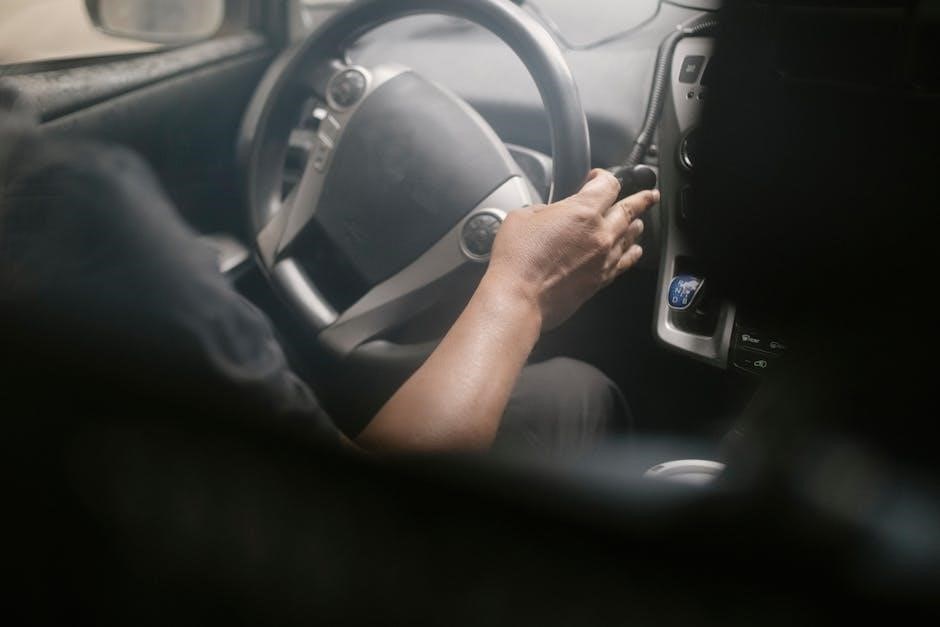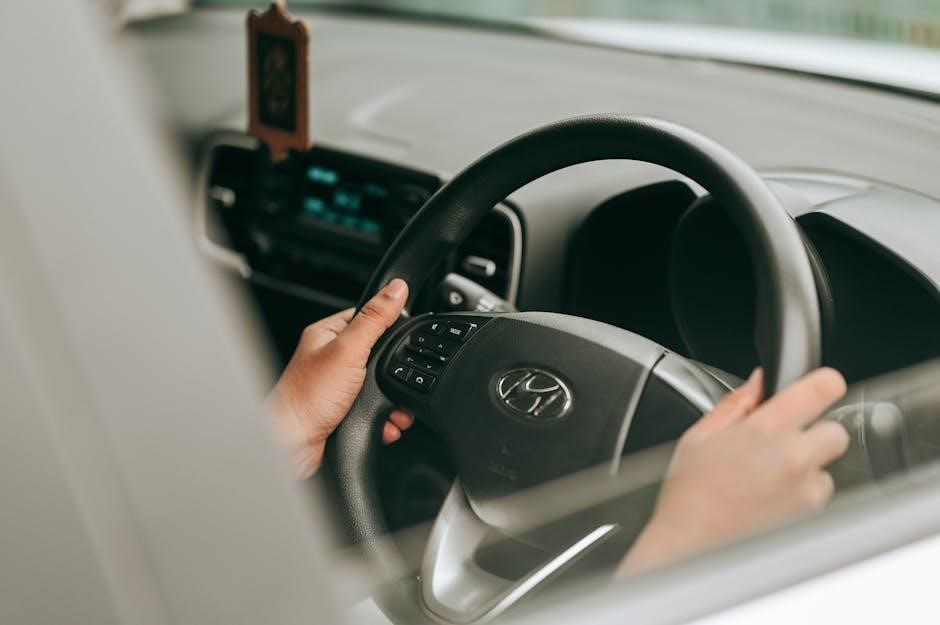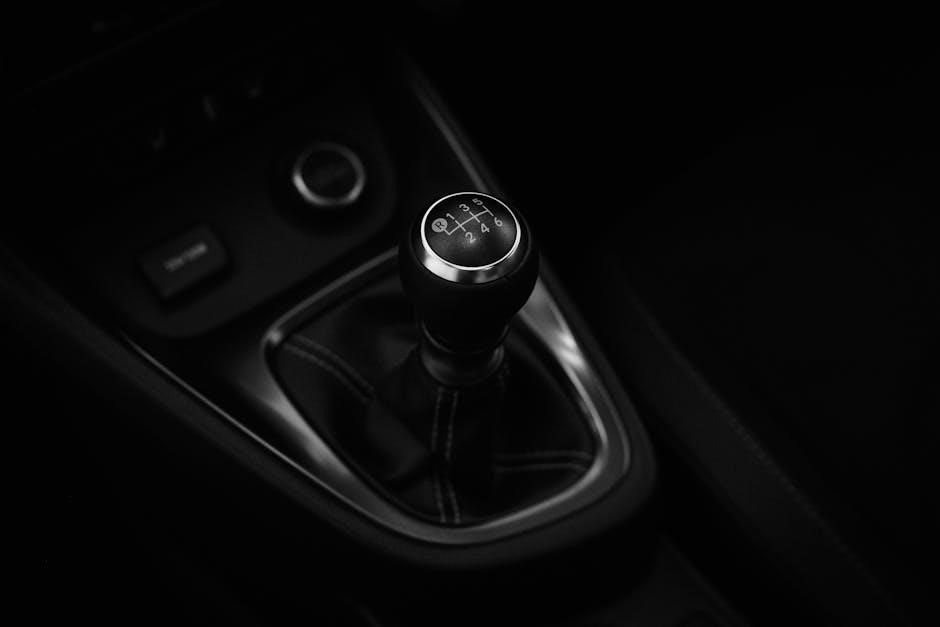minnesota drivers manual 2024
The Minnesota Driver’s Manual 2024 is a comprehensive guide published in September 2024, offering full-color detailed information on traffic laws, road signs, safe driving practices, and application processes․ It serves as an essential resource for new and experienced drivers, ensuring compliance with updated state regulations and promoting road safety․
1․1 Overview of the Manual
The Minnesota Driver’s Manual 2024 provides a detailed overview of driving rules, regulations, and best practices for safe and lawful driving in the state․ It is divided into sections covering traffic laws, road signs, driver’s license applications, and safety tips․ The manual includes full-color illustrations and clear instructions to help new and experienced drivers understand their responsibilities․ Available in both text and audio formats, it also offers resources for preparing for permit tests and understanding the application process for different types of licenses․ The manual is accessible online and in print, making it a versatile tool for drivers of all skill levels․ Key sections include traffic signals, defensive driving techniques, and emergency procedures․
1․2 Importance of the Manual for New Drivers
The Minnesota Driver’s Manual 2024 is an essential resource for new drivers, offering a clear understanding of traffic laws, road signs, and safe driving practices․ It serves as a primary study guide for preparing for the permit test, with detailed sections on defensive driving techniques and distracted driving laws․ The manual’s full-color format makes complex information easy to digest, while its structured approach ensures new drivers grasp critical concepts․ By studying the manual, new drivers can build confidence, reduce risks, and develop the skills necessary for safe and responsible driving․ It is a must-have tool for anyone seeking to obtain a Minnesota driver’s license and navigate the state’s roads effectively․

Eligibility Requirements for a Minnesota Driver’s License
To apply for a Minnesota driver’s license, individuals must meet specific eligibility criteria, including age requirements, residency verification, and submission of required documents․ Applications for new or renewed licenses began January 1, 2024, ensuring compliance with updated state regulations․
2․1 Age Requirements
In Minnesota, the age requirements for obtaining a driver’s license are designed to ensure safety and readiness․ Applicants must be at least 15 years old to apply for an instruction permit, which allows driving under adult supervision․ At 16 years old, individuals can apply for a provisional license, provided they have completed driver’s education and held the permit for at least six months․ Full driver’s license eligibility begins at 17 years old for those who have held a provisional license without violations․ These age-related requirements are strictly enforced to promote responsible driving habits and gradual skill development among young drivers․
2․2 Required Documents for Application
When applying for a Minnesota driver’s license, specific documents are required to verify identity, residency, and eligibility․ These include a valid form of identification, such as a birth certificate or passport, proof of Social Security number, and two documents confirming residency, like a utility bill or lease agreement․ Additional requirements may apply for special licenses, such as a limited or farm work license․ Applicants must ensure all documents are up-to-date and meet state guidelines․ It is advisable to check the official Minnesota Department of Public Safety website for the most current list of required documents to avoid delays in the application process․

Traffic Laws and Regulations in Minnesota
Minnesota traffic laws emphasize obedience to signs, signals, and right-of-way rules․ Speed limits and safe practices are enforced to ensure road safety and reduce accidents․
3․1 Speed Limits and Enforcement
Minnesota enforces strict speed limits to ensure road safety․ Urban areas typically have a 30-40 mph limit, while rural highways allow up to 70 mph․ School zones and construction areas have reduced speeds, often 20-40 mph․ Speed limits are enforced through police patrols, radar, and traffic cameras․ Drivers must adjust speeds according to road conditions, especially during rain, snow, or fog․ Exceeding speed limits can result in fines, increased insurance rates, or even license suspension․ The Minnesota State Patrol actively monitors highways to prevent reckless driving․ Understanding and adhering to posted speed limits is crucial for avoiding accidents and legal consequences․ Always drive at safe speeds to protect yourself and others on the road․
3․2 Traffic Signals and Right-of-Way Rules
Minnesota traffic signals and right-of-way rules are designed to ensure smooth and safe traffic flow․ Drivers must obey all traffic signals, including red, yellow, and green lights․ A red light requires a full stop, while a yellow light signals preparation to stop․ Green lights indicate it’s safe to proceed․ Right-of-way rules dictate who has priority at intersections․ At four-way stops, the first car to arrive goes first․ If two cars arrive simultaneously, the car on the right has the right-of-way․ Yield signs and traffic circles also require drivers to give priority to others․ Failure to follow these rules can lead to accidents or citations․ Always be attentive and courteous to other drivers․
Safe Driving Practices
Safe driving practices in Minnesota emphasize maintaining a safe distance, staying alert, and avoiding distractions․ Always use mirrors and check blind spots regularly․
Follow speed limits, use signals, and remain patient in heavy traffic․ Avoid aggressive driving and stay calm in challenging situations to ensure safety for all road users․
4․1 Defensive Driving Techniques
Defensive driving techniques are essential for minimizing risks on Minnesota roads․ Always maintain a safe following distance, allowing time to react to unexpected situations․ Stay alert and aware of your surroundings, including other vehicles, pedestrians, and road conditions․ Anticipate potential hazards and be prepared to respond․ Use mirrors and check blind spots frequently to stay informed about traffic around you․ Avoid aggressive driving behaviors like tailgating or speeding․ Defensive driving also involves being patient and courteous, such as yielding when necessary and avoiding distractions․ By adopting these practices, drivers can significantly reduce the likelihood of accidents and enhance overall road safety․
4․2 Distracted Driving Laws
Minnesota’s distracted driving laws aim to reduce accidents caused by divided attention․ Texting while driving is illegal for all drivers, and those with an instruction or provisional license cannot use cell phones at all․ Handheld phone use is prohibited in school zones and for novice drivers․ Drivers 18 and older can use hands-free devices but must keep both hands on the wheel․ Violations result in fines, with penalties increasing for repeat offenses․ These laws emphasize road safety, as distracted driving remains a leading cause of crashes in Minnesota․ Staying focused on driving is crucial for protecting yourself and others on the road․

Types of Driver’s Licenses and Permits
Minnesota offers various driver’s licenses and permits, including Instruction Permit, Provisional License, Full Driver’s License, and special licenses for limited, farm work, or medical needs․
5․1 Instruction Permit
An Instruction Permit is the first step for new drivers in Minnesota, allowing them to practice driving under the supervision of a licensed adult․ Applicants must be at least 15 years old to apply․ To obtain this permit, individuals must pass a vision test, a written knowledge test, and provide required identification documents․ The permit restricts driving to vehicles with a licensed adult (21+ years) in the front seat․ Additionally, permit holders cannot use cell phones while driving, even with hands-free devices․ This permit is valid for two years and is a prerequisite for obtaining a provisional license․ It helps new drivers gain experience before advancing to more independence behind the wheel․
5․2 Provisional License
A Provisional License in Minnesota is granted to drivers who have held an Instruction Permit and are ready for limited driving privileges․ To qualify, applicants must be at least 16 years old and have held the permit for at least 12 months (or 13 months if under 18 and not completing driver’s education)․ During this phase, drivers can operate vehicles without supervision but with restrictions․ They must complete 50 hours of supervised driving, including 15 hours at night․ The provisional license restricts the number of passengers under 20 years old to one unless they are family members․ Driving is also prohibited between midnight and 5 a․m․ unless accompanied by a licensed adult or in emergencies․ This phase helps transition toward full driving independence․
5․3 Full Driver’s License
A Full Driver’s License in Minnesota is issued to drivers who have successfully completed the provisional license phase․ To qualify, applicants must be at least 17 years old (or 18 if not completing driver’s education) and have held the provisional license for at least 12 months without major violations․ This license grants full driving privileges without restrictions on passengers or nighttime driving․ Holders are no longer required to display a provisional license sticker․ The full license is valid for four years and must be renewed before expiration․ It is the final step in Minnesota’s graduated driver licensing program, signifying independence and responsibility on the road․
5․4 Special Licenses (Limited, Farm Work, Medical)
Minnesota offers special licenses tailored to specific needs․ A Limited License restricts driving privileges to certain situations, like commuting to work or school, and is issued for medical or legal reasons․ Farm Work Licenses allow individuals aged 15-17 to operate farm machinery and vehicles for agricultural purposes without completing a driver’s education course․ Medical Licenses are granted to drivers with medical conditions that require special accommodations, provided they meet specific criteria set by the Minnesota Department of Public Safety․ Eligibility varies, and applicants must submit appropriate documentation․ These licenses ensure individuals can maintain mobility while adhering to necessary restrictions, promoting road safety and accessibility․

Application Process for a Driver’s License
The process involves submitting required documents, passing vision and knowledge tests, and paying fees․ Applicants must schedule and complete a driving test to obtain their license․
6․1 Steps to Apply for an Instruction Permit
To apply for an Instruction Permit in Minnesota, applicants must be at least 15 years old․ They need to provide proof of identity, residency, and legal presence․ A parent or guardian’s signature is required for minors․ Applicants must pass a vision test and a written knowledge test covering traffic laws and signs․ Study materials, such as the Minnesota Driver’s Manual, are available online․ There is a fee for the permit, and applicants can apply at any Minnesota Driver and Vehicle Services (DVS) office․ Once the tests are passed, the permit is issued, valid for two years․ Practice driving with a licensed adult is required before advancing to a provisional license․
6․2 Required Documents for License Application
To apply for a driver’s license in Minnesota, applicants must provide specific documents․ These include proof of identity, such as a valid passport or certified birth certificate․ A Social Security number verification, like a Social Security card, is also required․ Applicants must provide two proofs of residency, such as utility bills or bank statements․ For minors under 18, a parent or guardian must sign the application, providing their ID․ Additional documentation may be needed for name changes, such as a marriage certificate or divorce decree․ All documents must be originals or certified copies․ Ensuring all required documents are gathered beforehand streamlines the application process at the Driver and Vehicle Services (DVS) office․
6․3 Fees Associated with Licensing
The Minnesota Driver and Vehicle Services (DVS) charges specific fees for driver’s licenses and permits․ An Instruction Permit costs $10․ The Provisional License fee is $11․25, and the Full Driver’s License is $25․50 for applicants under 21, valid for four years․ For those 21 and older, the Full Driver’s License is $25․50 for a standard license, valid for four years․ Additional fees include $10 for a duplicate license or corrected card․ Payment methods accepted include cash, credit cards, checks, and money orders․ These fees cover administrative costs and ensure proper licensing․ Applicants should verify the exact fees before visiting a DVS office, as they may vary slightly depending on the type of license or service required․

Road Signs and Signals
Road signs and signals guide drivers, ensuring safe traffic flow․ They include warning, regulatory, and informational signs, helping drivers understand traffic laws and road conditions instantly․
7․1 Types of Traffic Signs
Traffic signs are categorized into several types to guide drivers effectively․ Warning signs alert drivers to potential hazards, like curves or pedestrian crossings, using yellow backgrounds․ Regulatory signs, such as speed limit or stop signs, enforce traffic laws and are typically white or red․ Informational signs provide guidance, like directions or road names, often in green or blue․ Guide signs help with navigation, especially on highways․ Construction signs inform drivers of work zones, while emergency management signs address situations like evacuations․ Understanding these categories helps drivers respond appropriately to roadway conditions and maintain safety․
7․2 Understanding Pavement Markings
Pavement markings are essential for guiding drivers and ensuring safe traffic flow․ Solid lines indicate boundaries that vehicles should not cross, such as double yellow lines on highways․ Dashed lines suggest separations between lanes where crossing is allowed․ Arrows and symbols, like directional arrows or pedestrian figures, guide drivers and pedestrians; Colors play a role: white lines for traffic separation and yellow for warnings or roadwork․ Understanding these markings helps drivers navigate roads safely, follow traffic rules, and anticipate potential hazards; Familiarity with pavement markings is crucial for new drivers to maintain order and reduce accidents on Minnesota roads․

Preparing for the Permit Test
Understanding the test format and focusing on key areas like traffic laws, road signs, and safe driving practices is crucial․ Review the manual thoroughly, and stay calm during the test to ensure success․
8․1 Study Materials and Resources
The 2024 Minnesota Driver’s Manual is the primary study resource for the permit test, offering detailed information on traffic laws, road signs, and safe driving practices․ Additionally, the Minnesota Department of Public Safety provides online practice tests and study guides to help applicants prepare․ The official MN Driver’s Manual is available for free download on their website, ensuring access to the most accurate and updated material․ Many third-party websites also offer study aids, including cheat sheets and interactive tools, which can supplement manual review․ Visual aids like diagrams and charts within the manual further enhance understanding of complex topics․ Utilizing these resources ensures a thorough preparation for the permit test․
8․2 Practice Tests and Online Resources
Preparing for the permit test can be enhanced through practice tests and online resources․ The Minnesota Department of Public Safety offers free practice tests on their website, featuring multiple-choice questions that simulate the actual test․ These tests cover topics like road signs, traffic laws, and safe driving techniques․ Additionally, third-party websites provide similar tools, often with interactive features and instant feedback․ Mobile apps like MN Driver Test Prep also offer on-the-go study options․ Utilizing these resources helps identify weak areas and builds confidence․ Regular practice ensures familiarity with the test format and content, increasing the likelihood of success․ These tools complement the manual effectively, making preparation more engaging and efficient․

Driving Test Preparation
Preparation for the driving test involves understanding the test format, practicing vehicle control, and demonstrating safe driving habits․ Regular practice helps build confidence and readiness․
9․1 What to Expect During the Test
The driving test evaluates your ability to operate a vehicle safely and confidently․ It begins with a pre-drive check to ensure the vehicle is roadworthy․ You’ll demonstrate basic vehicle control, such as starting, stopping, and turning․ The test includes driving in various traffic conditions, including straight roads, intersections, and potentially merging onto busy roads․ The examiner will observe your ability to follow traffic laws, use signals, and maintain safe distances․ Specific maneuvers, like three-point turns or parallel parking, may be required․ The test also assesses your ability to handle emergencies and unexpected situations․ Reviewing the Minnesota Driver’s Manual 2024 beforehand ensures familiarity with test-day expectations and procedures․
9․2 Common Mistakes to Avoid
During the driving test, common mistakes include failure to check blind spots, improper use of turn signals, and incorrect lane positioning․ Forgetting to yield the right-of-way or not stopping fully at stop signs can also lead to failure․ Excessive speeding, even by a few miles per hour, is another frequent error․ Additionally, distractions, such as using a phone or engaging in conversation, can negatively impact performance․ Many applicants also fail to check mirrors and blind spots regularly, demonstrating poor situational awareness․ Avoiding these mistakes requires careful preparation and attention to detail․ Practicing defensively and staying calm will help minimize errors during the test․

Driver Responsibilities and Safety Tips
Driver responsibilities include following traffic laws, maintaining vehicle safety, and practicing defensive driving․ Always stay alert, avoid distractions, and keep a safe distance from other vehicles․
10․1 Sharing the Road with Other Vehicles
Sharing the road safely requires courtesy, awareness, and adherence to traffic laws․ Always use turn signals to indicate your intentions and maintain a safe distance from other vehicles․ Be mindful of motorcycles, bicycles, and pedestrians, as they have the same rights but may be less visible․ When driving near large trucks or buses, avoid blind spots and never cut off their path․ Yield to emergency vehicles and follow right-of-way rules at intersections․ Stay patient and avoid aggressive driving behaviors, as this promotes a safer environment for all road users․ Understanding the needs of others on the road reduces accidents and enhances overall traffic flow․
10․2 Emergency Procedures and Accident Response
In the event of an emergency or accident, stay calm and follow proper procedures to ensure safety․ If involved in a collision, move to a safe location and turn on hazard lights․ Call 911 immediately if there are injuries or significant damage․ Exchange information with all parties, including names, phone numbers, and insurance details․ Document the scene with photos and notes․ If your vehicle breaks down, stay in your car with seatbelts fastened until help arrives․ For medical emergencies, provide first aid if trained, but avoid moving injured individuals unless necessary․ Keep an emergency kit in your vehicle, including items like a flashlight, jumper cables, and a first aid kit․ Always report accidents to the authorities as required by Minnesota law․

Maintaining Your Driver’s License
Maintaining your Minnesota driver’s license involves keeping it up to date, renewing it regularly, and updating personal information․ Avoid violations to prevent suspension and ensure driving privileges remain valid․ Always check the expiration date to renew timely and follow state guidelines for license maintenance․
11․1 Renewal Process
Renewing your Minnesota driver’s license is a straightforward process that ensures your driving privileges remain valid․ Licenses typically expire every four years, and renewal notices are mailed approximately 30 days before the expiration date․ You can renew online, by mail, or in person at a Driver and Vehicle Services (DVS) office․ Required documents include proof of identity, residency, and legal presence․ Fees vary based on the type of license, and payment methods are accepted online or in person․ A vision test may be required for in-person renewals․ If your license has been expired for more than one year, additional steps may be necessary․ Always check the Minnesota Department of Public Safety website for the most accurate renewal information․
11․2 Address and Information Updates
Keeping your driver’s license information up to date is crucial for maintaining accurate records with the Minnesota Department of Public Safety․ If you move or experience a change in personal details, you must update your information within 30 days․ Updates can be made online, by mail, or in person at a Driver and Vehicle Services (DVS) office․ Required documents include proof of identity and residency․ Name changes also require legal documentation, such as a marriage certificate or court order․ Failure to update your information may result in complications when renewing your license or receiving important notifications․ Always verify the DVS website for specific requirements before making changes․
The Minnesota Driver’s Manual 2024 serves as a comprehensive guide for drivers, providing essential information to ensure safe and lawful driving practices; From eligibility requirements to traffic laws, and from license applications to emergency procedures, the manual covers everything needed to navigate Minnesota’s roads confidently․ It emphasizes the importance of defensive driving, adherence to traffic rules, and continuous learning for all drivers, regardless of experience․ By understanding and following the guidelines outlined, drivers can contribute to a safer and more efficient transportation system․ Staying informed and responsible behind the wheel is crucial for protecting yourself and others․ Always refer to the manual for updates and best practices in driving․
